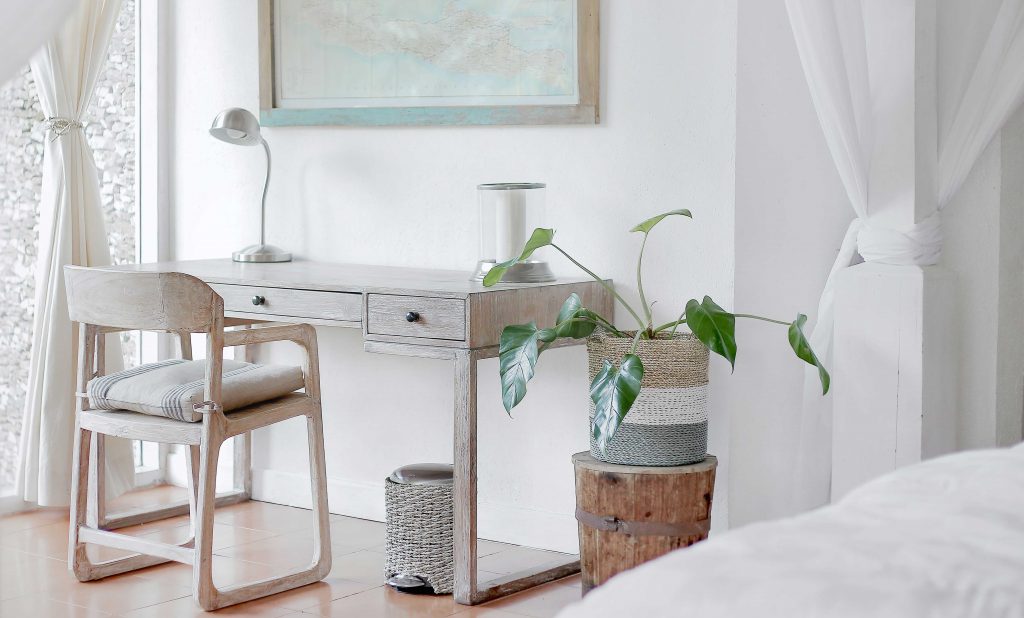The recent rise of e-learning and remote working has left many people hastily trying to assemble some kind of workspace(s) in their home. However, that kind of approach may not exactly be conducive to your best work. Taking a step back to assess the space you have is important in building a suitable office for anyone planning to work or study from home.
If you are considering creating something more permanent in your apartment or house, you have an opportunity to do it sustainably – creating a zero-waste workspace is one way to improve your concentration while remaining eco-conscious. Here, we go through what you need so that you can build a sustainable home office for either work or school.
The Zero-Waste Workstation
 A comfortable workstation with everything you need on-hand is really the baseline you should be working towards. In fact, not only should your workstation provide a dedicated space away from distractions, but it also has health implications, as slouching over a tiny desk with a laptop or sitting awkwardly in a cramped corner is uncomfortable.
A comfortable workstation with everything you need on-hand is really the baseline you should be working towards. In fact, not only should your workstation provide a dedicated space away from distractions, but it also has health implications, as slouching over a tiny desk with a laptop or sitting awkwardly in a cramped corner is uncomfortable.
At its core, this means a desk, a chair, storage, and ideally, something to ensure your computer screen is at the right height so you can maintain a healthy posture. The good news is that you can source all of these items in line with the zero-waste hierarchy, and whether it’s going secondhand through resources like Letgo or AptDeco, building your own, renting, or using innovative zero-waste products, there are plenty of options that are both functional and stylish.
If it’s professional office furniture you’re looking for, then cubicles.com has a huge range of secondhand gear that’s made for productivity. Alternatively, for something more in line with your style, you can find plenty of options for desks made from reclaimed wood or other recycled materials on Etsy or similar websites.

Source: fastcompany
Going with a secondhand office chair is another excellent way to keep usable items in the loop, however, there are other alternatives if you don’t want to commit to an ergonomic office chair. Sticking with all wood is a good idea, as the less plastic the better, and these single-sheet ply chairs are a good bet.
When it comes to storage, there are several options that are not plastic. Not only is plastic petroleum-based and highly polluting, but it’s rarely built to last. Buy products that will stand the test of time, such as draws and shelves made from sustainably sourced wood, or even try these Ikea-approved ideas for smaller items.
Finally, to keep your posture and head at the right height (no matter how many late nights and early mornings you may have), Oakywood’s range of laptop and monitor stands are sustainably-sourced. Manufactured with FSC solid wood and stainless steel, these stylish pieces of furniture are made to ensure your back and neck aren’t straining as you get to work. Oakywood also plants a tree for each product you buy from their online store, with more than 2,600 trees planted to date.
Zero-Waste Stationary Cupboard

Source: wisdomsupplyco
Even if most of our work is now done on computers, there are still plenty of occasions when you’ll need to go down a more conventional route. Luckily, there are many options when it comes to stationery for your zero-waste home office and plenty of ways in which you can reduce and reuse materials too.
Today, most office and school supply stores will sell recycled pens, pencils, and notebooks, however, there are also dedicated zero-waste options available too. Wisdom Supply Co. craft a variety of beautiful and practical stationery items under the banner “waste is a design flaw”. This means each and every product in their selection is made to be reused, repaired, or recycled—and there’s even a seconds page where, rather than trash slightly damaged goods, they’re sold for a discount!
Zero-Waste Tech Lab
Sourcing zero-waste technology remains problematic, and since e-waste is one of the fastest-growing waste streams in the world, changing the way we consume electronics is among the most pressing issues facing the zero-waste movement. However, there are steps you can take today to minimize the impact of electronic devices in your zero-waste home office.
 Apple offers a trade-in program for the refurbishment or recycling of old equipment. Also, Windows computers offer easily interchangeable components. So, if you need a larger hard drive, more memory, or new PSU, you can swap out these modular parts yourself and keep your electronics in the loop.
Apple offers a trade-in program for the refurbishment or recycling of old equipment. Also, Windows computers offer easily interchangeable components. So, if you need a larger hard drive, more memory, or new PSU, you can swap out these modular parts yourself and keep your electronics in the loop.
In fact, many people believe that this kind of modular thinking is the key to unlocking zero-waste electronics, and the Fairphone is an excellent example of what this might look like. Replaceable modules mean that you can easily repair or upgrade your phone when broken or simply a bit outdated, and keep valuable resources in the loop for much longer.
The Zero-Waste Lounge

Source: zerowaste.com
Everyone needs to take a break from time to time and doing it the zero-waste way can be healthier and more sustainable for your entire household—since you can use many of these products in your everyday life as well as in your zero-waste home office.
Drinking plenty of water is the key to staying sharp after a long day at the computer screen, and these charcoal water filters will remove impurities and could improve the taste. And of course, there’s no space in the zero-waste home office for plastic straws, so try these stainless steel alternatives instead.
We’re sure you’re already making meal plans and optimizing your leftovers, however, if you need to pop out for a business lunch or group project, then this stainless-steel lunchbox make the ideal container for last night’s chili, pasta, or even just a sandwich. And don’t forget your reusable coffee cup to keep your caffeine levels up on those early mornings.
There are hundreds of ways to build a zero-waste workspace in your home and using the zero-waste hierarchy as your guide is the best way to assess and rethink every aspect of you set up. For more information on the zero-waste movement, and how y to strive for the zero-waste principles, then subscribe here and stay in the loop.

